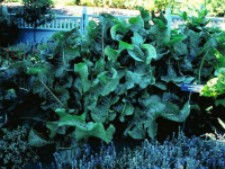
Other articles you might enjoy:
2. Create Your Own Signature Marinade
4. Celebrate Breakfast with Herbs and Spices
Make the most of culinary herbs and spices.

All About Horseradish
by Sandra Bowens
"The radish is worth its weight in lead; the black radish in silver--but the horseradish, in gold!" ---Apollo
Apollo may have "discovered" horseradish but he didn't share it. No actual record of using the potent root medicinally existed before the thirteenth century. John Gerard's 1597 Herball was the first culinary mention of horseradish when he cited it as a condiment eaten with fish and meat by the Germans. We do know that during the Middle Ages the Germans and Dutch enjoyed the leaves as a vegetable and used the plant medicinally as well.
Native to regions along the Caspian Sea from Russia to Finland, horseradish is now grown in northern parts of both Europe and the United States. Such a vigorous plant, it grows wild in the eastern Balkans and has actually come to be considered a noxious weed in some of the northern States.
Known botanically as Armoracia rusticana, horseradish is a perennial member of the mustard family. Its root is the spice but the plant will grow to about three feet offering leaves that are indeed tasty in salads. The Latin name, Cochlearia armoracia, refers to the hollowed, spoon like shape of the leaves that are similar to a cochlea snail.
The horseradish root has a remarkably pungent scent and equally memorable bite. The long, plump roots have no odor until broken or bruised. Once released, the flesh begins an enzymatic action where glycoside sinigrin reacts with the volatile oils capable of bringing tears to your eyes if inhaled.
Like mustard, horseradish has long been used externally as a poultice. Other medicinal uses, from ancient times and still today, include as a diuretic, expectorant and a cure for hoarseness. It is packed with Vitamin C--so much so that sailors used horseradish to prevent scurvy.
Cultivation of this potent spice begins with lengths of root approximately eight inches long. Horseradish grows best in moist, rich soil. The root cuttings will widen as they grow, spreading out rather than down so they should be spaced at 12-18 inch intervals. Planted as early as possible in the spring, the horseradish will produce a tall stalk of white flowers by midsummer. The seeds are often sterile thus explaining the need to propagate with root cuttings.
The roots are dug up in the late fall and protected from light to prevent them from turning green. Horseradish will keep for about three months if stored in a dark, cool, dry place like a root cellar or the vegetable drawer of a refrigerator. The roots should be scrubbed before storage and may become bitter after three months.
Freshly grated, horseradish is a traditional condiment to meats, tongue and oysters. It makes a zesty addition to dips, sour cream and sauces. Think of it with potatoes, smoked fish, on sandwiches or, as in the recipe that follows, with tomato juice.
Horseradish root is often available as a vegetable selection in the supermarket. Purchased this way, you can grate it as needed with a regular hand grater or food processor. Use care not to inhale the fumes or get the juice into your eyes.
You will also find jars of "prepared horseradish" among the other condiments at the market or as a granulated spice in mail order catalogs. Prepared horseradish may be simply grated or mixed with other ingredients and labeled as a sauce; this is ready to use as a condiment or in a recipe. Powdered horseradish is reconstituted with water or sprinkled like a spice.
If you decide you would like to grow horseradish, bear in mind that it will spread and could become hard to control. It is said that the plant is difficult to eradicate and you must dig up the tiniest root to keep it from coming back. Once you have tried it in the kitchen, we doubt you will ever see a need to get rid of it.
Mardi Gras Bloody Mary
Even without the vodka, this makes a fine, eye-opening beverage.
For each cocktail:
Lime or lemon wedge, optional
Kosher Salt, optional
2 Tablespoons vodka
1 teaspoon Worcestershire sauce
1 teaspoon lime juice
1/2 teaspoon prepared horseradish
1/4 teaspoon minced lemon zest
3 turns of the peppermill
2 drops hot sauce (like Tabasco)
Pinch cayenne pepper
Ice cubes
2 parts tomato juice
1 part V-8 vegetable juice
Optional garnishes: celery stalk, pickled okra or green bean, peperoncini, red onion wedges and/or lime wedge
If desired, salt the rim of a cocktail glass by slicing into a citrus wedge and rubbing it around the edge of the glass. Dip into Kosher salt.
Measure the vodka into the salted glass. Add the Worcestershire sauce, lime juice, horseradish, lemon zest, pepper, hot sauce and cayenne. Mix well and fill the glass with ice. Pour in enough tomato juice to fill the glass 3/4's of the way and top off with V-8 juice (or just use all tomato juice). Stir, add any or all of the optional garnishes and serve.
NOTE: For a true Mardi Gras theme, you would want to garnish with the traditional carnival colors of green, gold and purple. Use the green celery stalk, the yellow peperoncini and maybe a slice of red onion or a purple swizzle stick. Throw in a pickled okra just for a bit of Southern hospitality.
Here's one that's full of our favorite recipes because we wrote the book! It is also full of information, helpful hints and ideas for using herbs and spices in your kitchen.
There's more to salt than just the shaker, it is a life force. Follow along as it shapes the world.
All you need to know about method and technique complete with recipes for salsas, chutneys and spreads.
Herbal vinegars are some of the most versatile elixirs you can keep on hand or give as a gift. Here you will find inspiration, ideas and recipes for other delicious concoctions.





